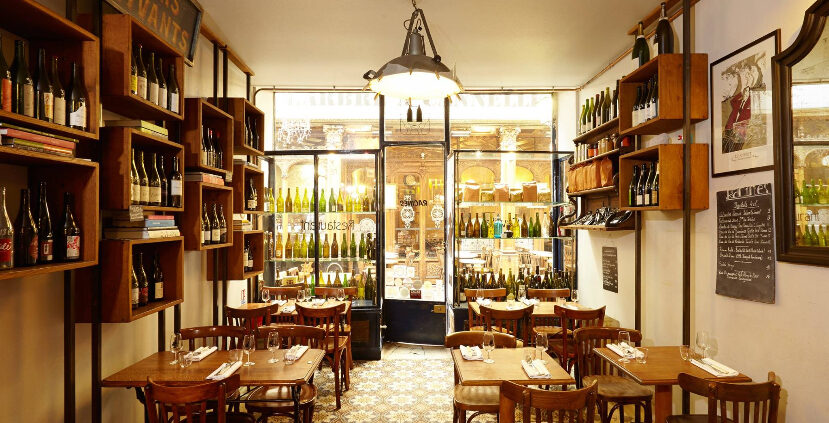
What springs to mind when you think of a traditional bistro in Paris? Perhaps it’s a quick espresso and a copy of Le Parisien, or a simple baguette and French onion soup. If you’re feeling lucky, a steak tartare. It certainly wouldn’t be the velvet folds of a parmesan risotto with crisp crepes, or perky cubed beetroot and streaks of aubergine on gold-rimmed ceramics. Neither, would you find casseroles that steam the eyes, crossed with plump pork Milanese or scampi risotto. Spooned between a vintage trinkets shop and a pitstop café, a Michelin-starred establishment sits in the disguise of an everyday Parisian bistro. If not for the gold-lettered signpost protruding from its exterior and chalkboards sprawling with daily specials of Sardinian origin, Racine’s boxed glass windows could be mistaken for an everyday bistro in Paris. However, this Michelin-starred hole in the wall is far from modest.
The bare-bones restaurant is helmed by the Sardinian chef Simone Tondo, whose dishes are a nod to the staples of a classic Italian trattoria. Tondo revives the seasonal Italian slow cooking formulas of his Nonnina Marissa and fuses them with traditional French bistro-style dining. At Racines Paris, the result is a delightful tug-of-war between the grilled meat and fish classics of Italy and no-nonsense French homestyle cooking and natural wines of a bistro-al-vins. Racines restaurant forges its own path through traditional Parisian dining, one of low-key luxury, and with a Michelin-starred stamp of approval.

Racine’s hidey-hole is an 18th-century former printing factory in the Passage de Panoramas in the 2nd arrondissement, one of the oldest arcades in Paris. Chef Tondo dove straight out of the kitchens of Milan, Miraxur and Menton, and into the restaurants of Paris, where he learnt the art of Parisian cooking. Finally, years later, he settled on his final project at Racines Paris. Honouring the restaurant’s name, which translates from the French ‘racines’ to ‘roots’ in English, chef Tondo digs into his Sardinian heritage to blend old-generation Italian recipes with Paris-learned culinary techniques, and conceives a carefully crafted daily menu where each meal is governed by seasonal produce and slow cooking, and paired with curated Italian natural wines.
Historically speaking, fine dining and bistro have not been a compatible pairing. However, unlike other Michelin restaurants in Paris, Racines restaurant transforms the old-style bistro model into a Michelin-starred establishment with high-level dishes such as Finocchiona sausage and risotto with crepes and parmesan. Yet, the interiors still have the traditional touch you’d expect of an arcadian bistro and all the hallmarks of Haussmann architecture. High ceilings and boxed glass windows stacked with bottles of natural wines give way to a narrow chamber lit by one domed hanging lamp and chrome streaks above the bar. On either side, thick cream walls are lined with freckled mirrors and black chalkboards sprawl with the day’s specials. Old oak tables and chairs with spindly legs and curved backs are crammed into the interior. Potted plants add a green touch, while the floor pays homage to the site’s 18th-century architecture with a marmalade Baroque design. And outside at Racines Paris, you can dine in traditional arcadian style, seated at one of the two tables out front, protected by the glass-domed roof.

While the restaurant is an ode to 18th-century Paris and a preservation of humble traditional bistro-style dining, Racine’s culinary creations are far from modest. An artisan of food in his own right, Chef Tondo can’t be pinned down to one exclusive menu. Every day, the chalkboards are enhanced with new dishes of Sardinian-French design. The meals depend upon fresh produce and simmer at length behind the wall of pots and pans that separates diners from the kitchen. The results are dishes with a supple flavour, from casseroles that steam the eyes to plump pork Milanese or scampi risotto, and even tagliatelle with beef cheek ragu. Cubed beet and streaks of eggplant are pricked onto gold-rimmed ceramic plates, each aperitif a certified objet d’art at Racines Paris.

While Racines is first and foremost an unusual encounter of Sardinian and French cuisine, it doubles up as bistro-al-vins. From the outside, the racks of dusted bottles of natural wines in the window frames could be mistaken for a wine merchant’s, rather than Racines Paris. However, as the Italian saying goes, ‘good wine makes good blood’ … and the restaurant’s curated collection of vin vivants is certainly blood-broiling. Offering only the finest elixirs, including the likes of Pierre Overnoy and Philippine Jambon, the careful selection of Italian and French wines makes sure that the wine is not just the first thing you see upon entering, but also the last taste that lingers on your tongue.
There’s a reason chef Tondo dubbed his restaurant a ‘bistrottoria’. The restaurant is just that. Unlike other Michelin restaurants in Paris, Racines presents a rare fusion of Sardinian and French cuisine and an unforeseen meeting of the French bistro with the Italian trattoria. With homespun interiors, precise presentation, and culinary craftsmanship, Racines Paris elevates traditional Parisian bistro-style dining to one of low-key luxury in the heart of 18th-century Paris.

